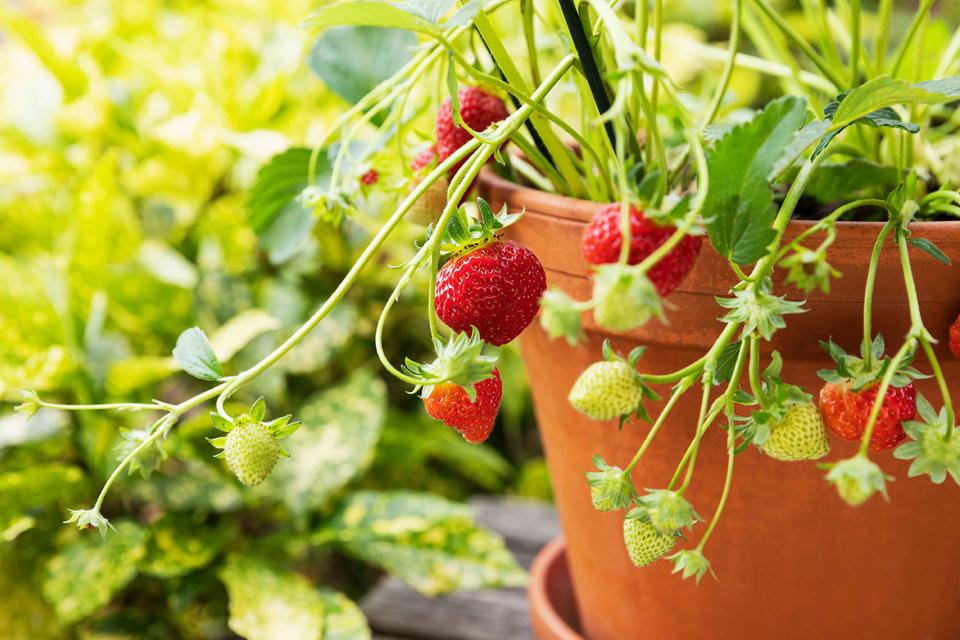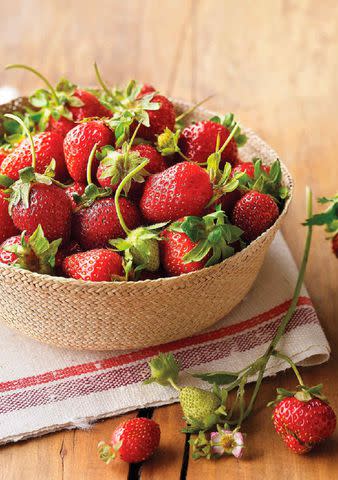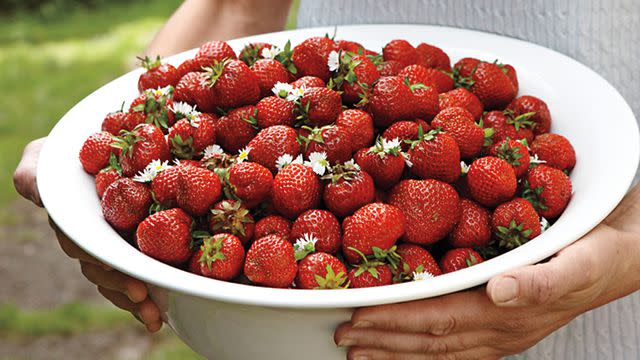How to Grow Sweet Strawberries That Will Produce Fruit Every Year
Strawberries are an easy fruit to grow and harvest—here's everything you need to know to enjoy them straight from your garden.

Westend61 / Getty Images
Anyone who has ever grown their own food knows just how much better it can taste when it’s picked straight from your garden, and that’s doubly true for strawberries. Home-grown strawberries can taste much sweeter than those you buy in the store since you’re able to wait until they are ripe and juicy before picking them. Plus, you can select varieties that prioritize taste over commercial considerations like size and durability.
Strawberries are pretty easy to grow, which means that almost anyone can get a chance to experience the joy of picking their summer haul directly from their own backyard, especially when you follow these expert tips.
Meet Our Expert
Taylor Montgomery, owner of Montgomery Sky Farm and executive chef at Urban Wren
Michael O’Brien, urban farmer and founder of Hommes + Gardens, a garden and landscape design company
Sarah Warner, greenhouse manager at the Case Western Reserve University Farm at Case Western Reserve University
Related: Use Our Companion Planting Chart to Grow a Thriving Vegetable Garden
Strawberry Varieties
There are three types of strawberries you can grow at home, according to Taylor Montgomery, farmer and executive chef at Urban Wren in Greenville, South Carolina. He says that each of these three types includes many different varieties.
June-bearing strawberries: Montgomery says that these can be harvested all at one time, and you’ll be able to tell them from some of the other varieties due to their larger size.
Everbearing strawberries: You can expect a couple of harvests throughout the season, according to Montgomery, who says this variety's berries are on the smaller side.
Day-neutral strawberries: These are similar to everbearing strawberries without the daylight requirements, according to Montgomery, who says that he likes to plant more than one type at Montgomery Sky Farm, depending on each year’s planting rotation.
"Eversweet everbearing strawberries work well in a larger space—I plant ours in the field due to their ability to withstand the heat of summer, their resistance to disease, and because the root system works well for the soil type in Western North Carolina," he says. "Honeoye strawberries are planted in the gardens around the farmhouse because of their cold hardiness, acceptance of some shade, and I like having a snack within arm’s reach."
That being said, you don’t need to own a big farm like Montgomery to have a bumper strawberry crop, according to Michael O’Brien, an urban farmer and founder of Hommes + Gardens. "Don't let limited space deter you from growing strawberries; they're perfectly suited for container gardening, making them an excellent choice for urban growers," says O’Brien. "With a bit of creativity and some vertical gardening techniques, you can enjoy a bountiful harvest even in the smallest of spaces."
O’Brien says that strawberries can be perennial, meaning they come back each year without the need for replanting, depending on your location and USDA hardiness zone. "This makes them a sustainable source of fresh fruit that requires minimal effort once established," he says.
Related: How to Grow Delicious Blueberries You Can Harvest Year After Year

Martha Stewart
The Best Time to Plant Strawberries
June-bearing strawberries can be planted in the fall and harvested the following spring, according to Montgomery, who recommends that first-year plants have the flower buds removed and additional runners cut so that the plant can establish itself within the soil for a more fruitful harvest in the second season. "Everbearing and day-neutral varieties can also be planted as early as December for a spring harvest," he says, depending on your hardiness zone.
When it comes time to put them in the ground, Montgomery says that your strawberry rows should be about 24 inches wide and mounded six inches high. "The rows should be three to four feet apart to allow ample room for walking and for plants to spread," he said.
How to Care for Strawberries
Consider these tips for growing healthy, delicious strawberries right at home.
Soil
For strawberries to thrive, the soil should be tested and amended so that the pH falls between 5.5 and 6.5. "Mature compost should be worked into the top six inches of soil before planting for vigor in growing and continued to be added throughout the season," Montgomery says.
Related: 10 Composting Tips That Will Keep Your Soil Healthy, According to Martha’s Head Gardener
Water
Healthy, thorough watering is essential—strawberries need at least an inch of water a week to produce juicy berries.
Light
Situate your strawberry plants so they'll receive at least eight hours of full, direct sun each day.
Fertilizer
Strawberries aren’t super heavy feeders, so you can use a balanced NPK fertilizer (10-10-10 and 20-20-20 are both good options), remembering to feed in early spring and then again when their fruits start to appear.
Mulch
To maintain healthy strawberries, Montogomery says that he uses a sterile straw around the plants to protect the berries since this acts as a weed barrier, and then he applies an additional layer of mulch on top. "One tidbit to keep in mind when planting strawberries in cold weather is that a covering will be needed," he says. "Mulch, temporary cold frames, or tunnel row coverings all are acceptable and useful in this application."
Companion Plants
Giving your strawberries the right neighbors can also lead to a more successful growing season. "Companion planting is another strategy that can enhance the success of your strawberry crop,” O’Brien says. "Thanks to their shallow root system and compact size, strawberries can be strategically placed throughout your garden, acting as beneficial companions to a variety of plants." He says you should consider planting them near herbs like basil or thyme to deter pests and attract beneficial insects. "Alternatively, placing strawberries near onions or garlic can help repel pests while enriching the soil," he says.
Related: Use Our Companion Planting Chart to Grow a Thriving Vegetable Garden
How to Propagate Strawberries From Runners
One of the benefits of cultivating strawberries at home is the opportunity to propagate them through their runners. "Runners are specialized stems that grow outward from the main strawberry plant, developing small plantlets or 'offshoots' at their tips," he says. "This propagation method mimics the way strawberries spread in nature, allowing them to reproduce and establish new plants."
To propagate strawberries using runners, O’Brien says you should follow these steps:
Identify healthy runners by looking for long, slender stems extending from the main strawberry plant that have healthy-looking offshoots at their tips.
Prepare the offshoot for propagation by gently separating the offshoot from the mother plant while keeping its roots intact using scissors or a small gardening knife.
Plant the offshoot in well-draining soil enriched with organic matter. "Dig a small hole for the offshoot, ensuring the roots are well-covered, but the crown (where the plant meets the roots) is slightly above the soil level," he says. "Firmly press the soil around the offshoot to secure it in place."
After planting, he says you’ll need to water the newly propagated strawberry offshoot thoroughly to help it establish roots. "Continue to water regularly, keeping the soil consistently moist but not waterlogged," he says. "Mulching around the plant can help retain moisture and suppress weeds."
Monitor growth by keeping an eye on the propagated offshoot as it establishes itself in its new location. "With proper care and maintenance, it will grow into a mature strawberry plant capable of producing fruit," says O'Brien.
"By propagating strawberries through runners, you can expand your strawberry patch without having to purchase additional plants," O’Brien says, adding that this method not only saves money but also ensures a consistent and abundant supply of delicious berries year after year.
Related: How to Plan Your Vegetable Garden the Right Way

Marte Kopperud
How to Harvest and Store Strawberries
Once you've mastered growing strawberries, you will want to know the best way to harvest and store them so your hard work won't go to waste.
Determining Ripeness
As for knowing when it’s the perfect time to pick your berries, Werner says it’s all about inspecting them for the perfect range of colors. "You can tell strawberries are ripe when they are completely red, and there is no sign of white or green on the berry," she says. "Typically, when the fruit first appears, they are very small and green; as they grow bigger, they start to turn white, then into red, indicating it's ready to harvest." She says that the frequency of harvest is typically every one to two days during the growing season.
Tips
Don’t pick your berries during the hottest part of the day. "Early morning harvests are best before the sun becomes too hot," Warner says, adding that all berries are very sensitive to high temperatures after they’ve been picked.
While it won't hurt to pick strawberries with a little bit of white, the berry may taste a bit bitter—but don't wait for too long before picking them. "Be sure to pick strawberries as soon as they are ready as they go bad within a day or two after ripening," Warner says.
How to Harvest Strawberries
The best way to pick strawberries is by taking the stem between two fingers and pinching until the stem breaks, according to Sarah Warner, greenhouse manager at the Case Western Reserve University Farm at Case Western Reserve University. Warner says you can also use hand shears to make this easier. "It really depends on if you would like one or two hands to harvest!" she says. "I personally find it easier to use one hand to pinch and pull the stem of the strawberry while holding a container in the other hand, making harvesting much faster."
Storing Fresh Strawberries
To keep your berries fresh after you’ve picked them, Werner says that you’ll need to ensure they’re completely dry before storing them; otherwise, you run the risk of mold. "The shelf life of strawberries can be extended by soaking them in white distilled vinegar for two minutes," she says, adding that you’ll still need to be sure you’ve fully rinsed and dried them before putting them away. "Placing a paper towel at the bottom of a mason jar will help to absorb any excess moisture and storing in an airtight mason jar with a lid will greatly extend the shelf life."
Related: How to Wash and Store Berries So They Stay Fresh Longer
Common Problems When Growing Strawberries
One of the most common issues with strawberries is seeing flowers but no fruit. "This can be so devastating after waiting for a year to pick fresh strawberries," Warner says, adding that this can be caused by a lack of pollination, poor soil, nutrient deficiency, or pests. "It is always important to inspect your plants at least once a week for pests to get ahead of the problem. You can figure out which type of pest you’re dealing with by looking at an insect ID app before taking action. Sometimes, there are insects present that are good guys!"
If a lack of pollination is causing your berry problems, Werner says that this can be easily fixed by planting flower varieties alongside strawberries that pollinators love, like bee balm or borage. "Poor soil and nutrient deficiencies can be uncovered by taking a soil test and sending it to a local company for thorough testing," she says. "This will tell you what nutrients are lacking in your soil and how you can amend it."
Lastly, your strawberries just may not be ready to bloom yet. "Depending on where you live and what variety, strawberries will bloom at different times of the year," Werner says.
Related: 15 Pollinator Plants That Will Attract Birds, Bees, and Butterflies to Your Garden
Read the original article on Martha Stewart.

